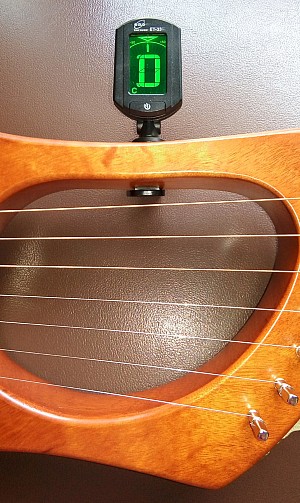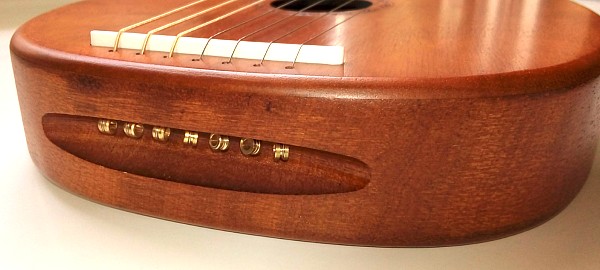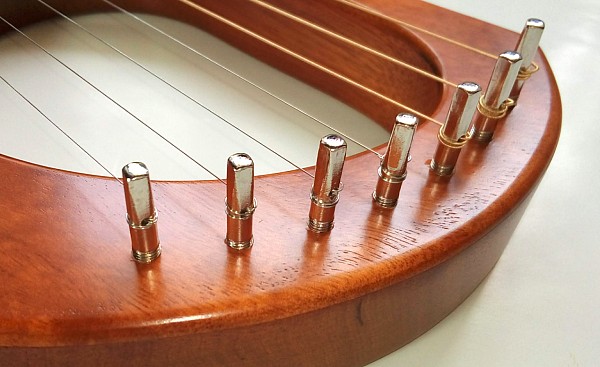The lyre appears many times in the Psalms.
What's the difference between a harp and a lyre? Sometimes they are the same, but the lyre is more ancient. The lyre was also smaller and more portable than a harp. David apparently carried around a lyre and played it as he watched over his sheep in the field.
Lyres are especially helpful in situations where you sing the Psalms silently. They can accompany the singing in your head and give you a voice. But the lyre would have to be so simple that you could play it without looking because you need your eyes for reading the words.
Today several types of lyres can be easily obtained today, and the most common ones have 7 strings or 10 strings. A 10 string lyre is not as simple to play as a 7 string lyre, but more versatile if you are up to the challenge.
Two different scales
Most of these lyres have the thicker strings on the left which I prefer. Some lyre makers might have the strings in the opposite order, but it looks like the body design is identical and the vendors just string them differently.
Ten string lyres usually come with one of two different ranges of notes, both in the key of C.
The G-B range
One of these has (from low to high) G A B C D E F G A B. This range of notes spans both the bass and treble clef.
 Do from the Do Re Mi scale would be on the fourth string from the bottom (left).
Do from the Do Re Mi scale would be on the fourth string from the bottom (left).
The E-G range
The other has (from low to high) E F G A B C D E F G. This range exactly corresponds with the notes on a treble clef.
 Do from the Do Re Mi scale would be on the sixth string from the bottom (left) so it is in the middle of the strings.
Do from the Do Re Mi scale would be on the sixth string from the bottom (left) so it is in the middle of the strings.
Back to the top
Which range should you choose?
Yes, this can be confusing. There are also some 10 string lyres with notes that go from A to C.
The type with the G-B range such as the one by
Donner is currently a best seller at Amazon, but the majority of 10 string lyres online that provide such details have the E-G range such as this one by TOYANDONA.
If you get one and then decide you prefer the other, you could retune the lyre, but going from the E-G range to the G-B range would let you tune down instead of up, and there would be less risk of breaking strings.
You might also want to get a lyre that doesn't have the notes stamped near the tuning pegs so you won't feel bound to one particular range of notes, and could even go Pentatonic if you like, which is possible according to some makers and reviewers.
Back to the top
Gregorian Psalm tones
I have written about Gregorian Psalm tones in a different article called How to chant the Liturgy of the Hours
with Gregorian Chant and a digital Breviary. I go into more detail in that article, so you might want to stop and read it before going further here.
The main feature of that article is a set of five of the easiest Gregorian Psalm tones which can be chanted with the Liturgy of the Hours.
I have put those same five Psalm tones into 10 string tablature for this lyre. I made two versions as PDFs, one for each range of notes:
The G-B range: 10_string_gregorian_gb.pdf.
The E-G range: 10_string_gregorian_eg.pdf.
The images below are SVG files so you can pinch out and zoom in to see details.
The format
As you can see, these are not standard music scores with five lines. They are more similar to guitar tablature where each line represents a string.
Each line is marked with the letter of the note, either G A B C D E F G A B or E F G A B C D E F G plus their names from the Do Re Mi scale. There is also a red marker for Do from the Do Re Mi scale.
So you don't have to be able to read music to use this; I wanted it to be as simple as possible and accessible to everyone.
 Since this is 10-line tablature for a lyre and not a music score for singing, I used familiar round notes which are very different from traditional square neumes.
Since this is 10-line tablature for a lyre and not a music score for singing, I used familiar round notes which are very different from traditional square neumes.
At the right you can see the same Psalm tone in both 10-line tablature and traditional Gregorian notation.
The three sections
The Liturgy of the Hours (a.k.a The Divine Office, a.k.a the Breviary) divide the Psalms into smaller sections for chanting.
Some breviaries including the digital iBreviary and Universalis have special navigation symbols to help identify the number of lines in these sections.
Three line groupings are marked with a flex (a.k.a dagger) after the first line and the second line is marked with an asterisk.
Two line groupings are marked with an asterisk at the end of the first line.
Most of the time there will be no flex but only an asterisk because the sentence is divided only into two lines. In that case you ignore the top part of the notation that has a flex and go straight to the second part that has an asterisk.
English words have different numbers of syllables that require shifts in emphasis or accents. When the final word happens to be "Jerusalem" or "unsurpassable" you will need to add those extra notes to make the words sound natural. I hear Latin is much easier to chant.
Anyway, it all becomes natural with repetition over time.
If you are playing a lyre, you probably don't want to be fiddling with pages in a book.
That's where the split screen feature on both Android tablets and iPads is really valuable.
I made these PDFs in a tall and narrow format so they will fit in a split screen on a tablet. If you print them out, they might make nice bookmarks as well.
As I mentioned above, iBreviary (the website and the app) and Universalis (the app) include asterisks and flexes to signify groupings of two or three lines. This is a very helpful feature for chanting the Psalms.
You will need exactly five Psalm tones for the Psalms and canticles in Morning Prayer and Evening Prayer in the Liturgy of the Hours, so you can just start with the first one and work your way down to the last one each time.
What about the hymn?
Both iBreviary and Universalis usually have a hymn that is written in Long Meter. In iBreviary if you scroll to the end of a hymn you will see the tune's name followed by the letters LM or the numbers 8 8 8 8.
An example of Long Meter is the Doxology or Old 100th (Praise God from whom all blessings flow...).
I have two personal favorite Long Meter tunes which work very well with iBreviary and Universalis. One is Tallis' Canon and the other is Winchester New. Both of these are simple, dignified, and easy to remember. In case you don't know them, I have made simple mp3 piano demos of both:
Lately I have been using a new Long Meter hymn which I had composed in the Pentatonic scale for the 7 string lyre. It's such a simple tune that I wouldn't be surprised if someone else has already come up with it. If you know of an earlier version of this, please let me know. But for now, since I need to give it a name, I've just attached my own name.
I think it would be easy enough to learn these tunes by heart on a 10 string lyre. You could even pencil the notes on a special tablature sheet which I mention in the next section.
Back to the top
Practical tips
Here are a few practical tips to help you get the most out of one of these lyres and avoid mistakes. This section is identical to the practical tips in the article on the 7 string lyre.
Tuning
The lyre will not come to you tuned, so you will have to tune it yourself. They usually keep the strings loose and out of tune so they won't snap in transit. But my lowest string was actually tuned much higher than it should have been.
A clip-on guitar tuner is really handy, and they are very cheap. Most guitar tuners have a chromatic tuner option so you can find notes that are not on a guitar. Clip it on the lyre, and it tells you the note from the vibrations.
Tuning a lyre is delicate business, and a slight nudge will send the note up a few steps. So you need to be very careful to not go too sharp and accidentally snap the strings.
 Always tune the string from below the note and carefully tighten the tuning wrench clockwise to tune up to the note. Pluck the string before you tighten the tuning peg and use your ears to hear the note and eyes to watch the tuner. If you miss the proper pitch, loosen the string a little and try again.
Always tune the string from below the note and carefully tighten the tuning wrench clockwise to tune up to the note. Pluck the string before you tighten the tuning peg and use your ears to hear the note and eyes to watch the tuner. If you miss the proper pitch, loosen the string a little and try again.
After you first tune the strings to proper pitch on your new lyre it will take a while for the strings to settle, and they will constantly go flat for the first few hours. This is because the strings are still stretching, and will continue to stretch for a while until they settle.
Even while you are tuning, you will find that several strings which were tuned have suddenly gone flat. When the strings are tightened, the tension on the instrument increases and shortens it slightly, so the strings go slack (and flat).
You just have to tune the strings a few times until they stop going flat.
From the day after I tuned it, my relatively cheap lyre stayed in tune better than my acoustic guitars which cost several times more than the lyre.
But some lyres will not stay tuned and you can even see the pegs quickly unwinding by themselves. I read a useful comment that said to just unscrew the peg entirely, and add a drop or two of nail polish remover to it and screw it back in. Apparently that will fix the problem.
String replacement
Fortunately 10 string replacement sets for these lyres have recently appeared on the market.
Make sure you get metal strings with the metal ring-type stoppers (a.k.a. "ball ends"). The nylon strings have no stoppers and will probably be a hassle to fasten (I have not tried it).
 The ball ends can be seen in the groove. That white bar is the bridge.
The ball ends can be seen in the groove. That white bar is the bridge.
Concerning the actual stringing of the lyre with new strings, you have to first unscrew the tuning pegs a bit so that when you screw them back in to tighten the new strings, the pegs will return to their former height.
 The tuning pegs
The tuning pegs
Also, the strings may be much longer than what you would need, so you will just have to cut them. Cut the string about two inches past the tuning peg so it will have enough slack to wind around the tuning peg a few times.I like to have enough to wrap around the peg four or five times, but no more.
Make sure to observe how the old strings were originally attached before you remove them. They should tighten (pitch goes up) by turning them clockwise.
There are ways of anchoring the strings to the pegs, and you can find out more by checking web articles or YouTube videos about how to change guitar strings; the process is the same for lyres and guitars, and there are several ways depending on your personal preference.
First published on May 3, 2024
Last updated on June 20, 2024